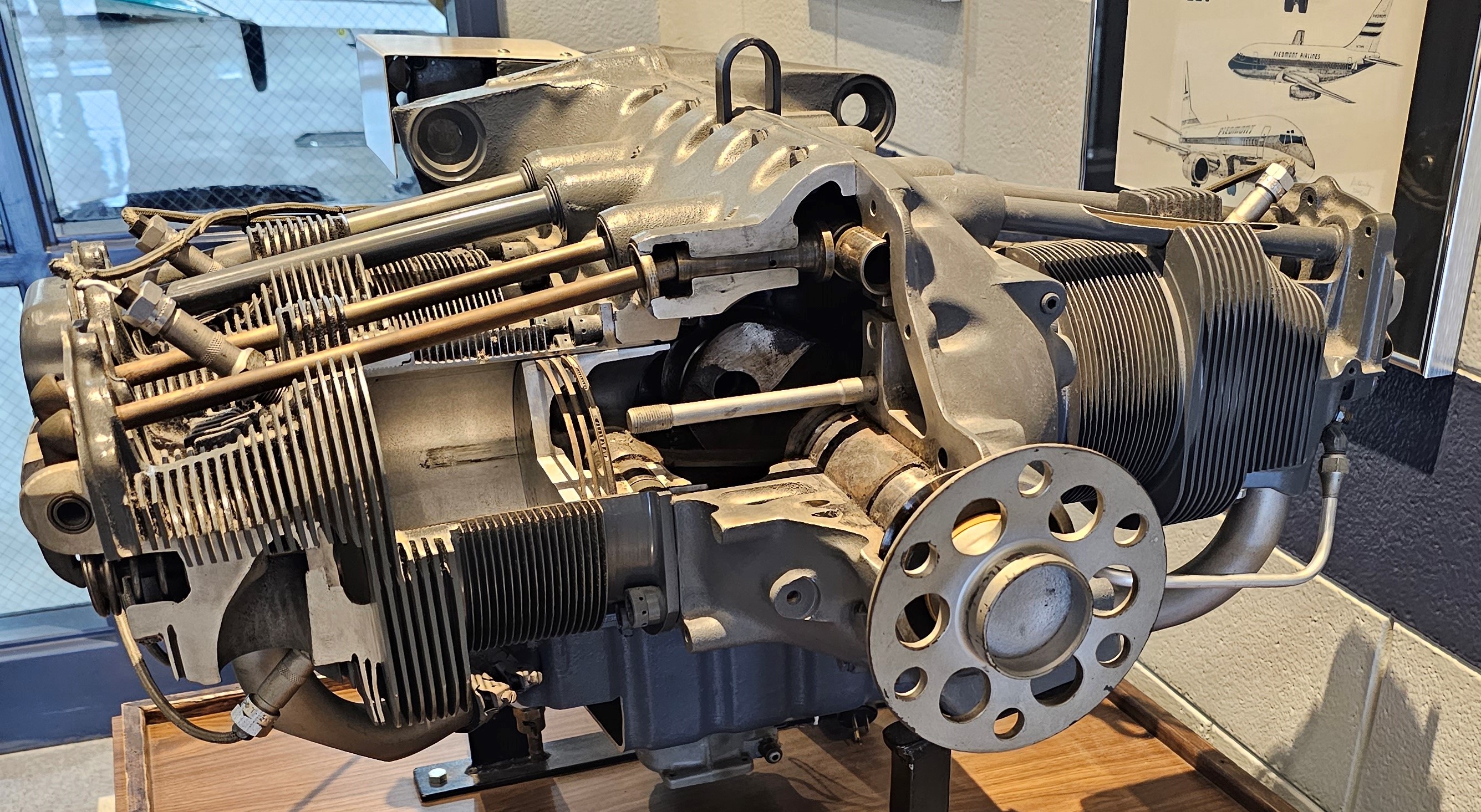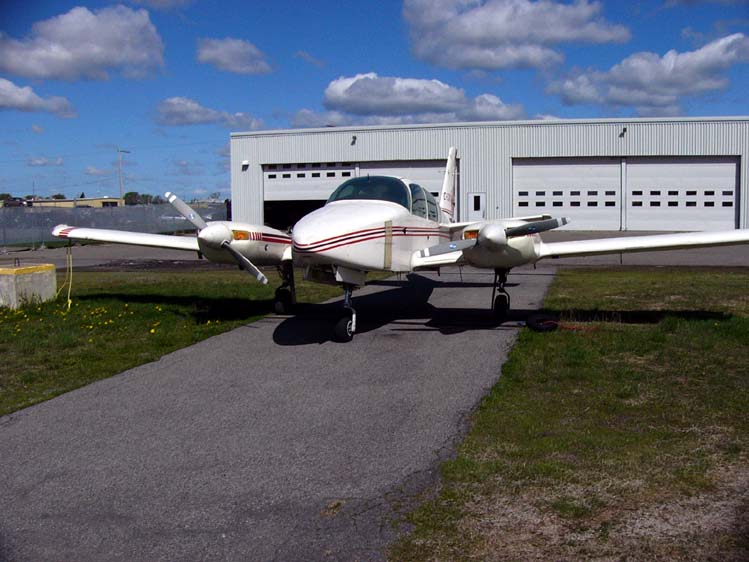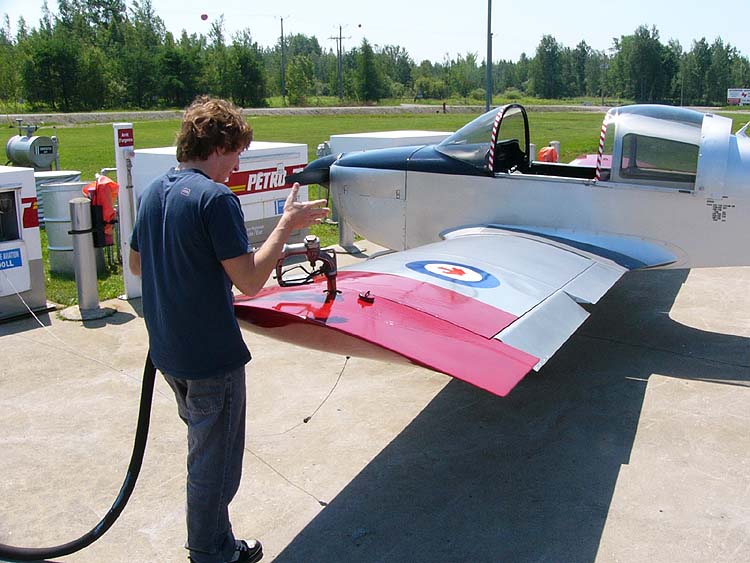|
Lycoming IO-320
The Lycoming O-320 is a large family of naturally aspirated, air-cooled, horizontally-opposed four-cylinder, direct-drive engines produced by Lycoming Engines. Introduced in 1953, it is commonly used on light aircraft such as the Cessna 172 and Piper Cherokee, and remains in production as of 2024. Different variants are rated for 150 or 160 horsepower (112 or 119 kilowatts). Design and development The O-320 family of engines includes the carbureted O-320, the fuel-injected IO-320, the inverted mount, fuel-injected AIO-320 and the aerobatic, fuel-injected AEIO-320 series. The LIO-320 is a "left-handed" version with the crankshaft rotating in the opposite direction for use on twin-engined aircraft to eliminate the critical engine. The first O-320 (with no suffix) was FAA certified on 28 July 1953 to CAR 13 effective 5 March 1952; this same engine was later re-designated, without change, as the O-320-A1A. The first IO-320 was certified on 10 April 1961, with the AIO-320 foll ... [...More Info...] [...Related Items...] OR: [Wikipedia] [Google] [Baidu] |
WikiProject Aircraft
A WikiProject, or Wikiproject, is an affinity group for contributors with shared goals within the Wikimedia movement. WikiProjects are prevalent within the largest wiki, Wikipedia, and exist to varying degrees within Wikimedia project, sibling projects such as Wiktionary, Wikiquote, Wikidata, and Wikisource. They also exist in different languages, and translation of articles is a form of their collaboration. During the COVID-19 pandemic, CBS News noted the role of Wikipedia's WikiProject Medicine in maintaining the accuracy of articles related to the disease. Another WikiProject that has drawn attention is WikiProject Women Scientists, which was profiled by ''Smithsonian Magazine, Smithsonian'' for its efforts to improve coverage of women scientists which the profile noted had "helped increase the number of female scientists on Wikipedia from around 1,600 to over 5,000". On Wikipedia Some Wikipedia WikiProjects are substantial enough to engage in cooperative activities with outsi ... [...More Info...] [...Related Items...] OR: [Wikipedia] [Google] [Baidu] |
Aerobatics
Aerobatics is the practice of flying maneuvers involving aircraft attitudes that are not used in conventional passenger-carrying flights. The term is a portmanteau of "aeroplane" and "acrobatics". Aerobatics are performed in aeroplanes and gliders for training, recreation, entertainment, and sport. Additionally, some helicopters, such as the MBB Bo 105, are capable of limited aerobatic manoeuvres. An example of a fully aerobatic helicopter, capable of performing loops and rolls, is the Westland Lynx. Most aerobatic manoeuvres involve rotation of the aircraft about its longitudinal (roll) axis or lateral (pitch) axis. Other maneuvers, such as a spin, displace the aircraft about its vertical (yaw) axis. Manoeuvres are often combined to form a complete aerobatic sequence for entertainment or competition. Aerobatic flying requires a broader set of piloting skills and exposes the aircraft to greater structural stress than for normal flight. In some countries, the pilot must wea ... [...More Info...] [...Related Items...] OR: [Wikipedia] [Google] [Baidu] |
Gulfstream American GA-7 Cougar
The Gulfstream American GA-7 Cougar is an American all-metal, 4-seat, twin-engined light aircraft. The Cougar was a twin-engine development of the Gulfstream American AA-5B Tiger and traces its lineage to the AA-1 Yankee Clipper and the Bede BD-1. Development As a development of the company's single-engined designs, Grumman American developed a twin-engined version, designated the GA-7 which it named the Cougar, in keeping with the existing Lynx, Cheetah and Tiger names for aircraft in the company's line. The prototype Cougar with two Lycoming O-320 engines first flew on the 29 December 1974. The prototype had a sliding canopy but this was soon changed to a starboard side door on the production aircraft. With other rework required the production prototype did not fly until 14 January 1977.Wood, Derek: ''Jane's World Aircraft Recognition Handbook'', page 233. Jane's Publishing Company, 1982. Before production started the company was taken over on 1 September 1978 by Am ... [...More Info...] [...Related Items...] OR: [Wikipedia] [Google] [Baidu] |
Robinson R22 Engine Detail
Robinson may refer to: People and names * Robinson (name) Fictional characters * Robinson Crusoe, the main character, and title of a novel by Daniel Defoe, published in 1719 Geography * Robinson projection, a map projection used since the 1960s to show the entire world in two dimensions * Robinson (crater), a small lunar impact crater southwest of the large walled plain J. Herschel ;United States * Robinson, Illinois * Robinson, Iowa * Robinson, Kansas * Robinson, Kentucky * Robinson, Minnesota * Robinson, North Dakota * Robinson, Texas * Robinson Township, Allegheny County, Pennsylvania * Robinson Township, Washington County, Pennsylvania * Robinson, Indiana County, Pennsylvania ;United Kingdom * Robinson (Lake District), a 737 m hill in England's Lake District * Robinson College, Cambridge, a college in England's University of Cambridge ;France * Robinson (Paris RER), a commuter train station in Paris Ships * USS ''Robinson'', the name of more than one United St ... [...More Info...] [...Related Items...] OR: [Wikipedia] [Google] [Baidu] |
Avgas
Avgas (aviation gasoline, also known as aviation spirit in the United Kingdom, UK) is an aviation fuel used in aircraft with spark-ignited internal combustion engines. ''Avgas'' is distinguished from conventional gasoline (petrol) used in motor vehicles, which is termed ''mogas'' (motor gasoline) in an aviation context. Unlike motor gasoline, which has been formulated without lead since the 1970s to allow the use of catalytic converters for pollution reduction, the most commonly used grades of avgas still contain tetraethyllead, tetraethyl lead, a toxic lead-containing additive used to aid in lubrication of the engine, increase octane rating, and prevent engine knocking (spark-knock). There are ongoing efforts to reduce or eliminate the use of lead in aviation gasoline. Kerosene-based jet fuel is formulated to suit the requirements of gas turbine, turbine engines which have no octane requirement and operate over a much wider flight envelope than piston engines. Kerosene is also ... [...More Info...] [...Related Items...] OR: [Wikipedia] [Google] [Baidu] |
United States Dollar
The United States dollar (Currency symbol, symbol: Dollar sign, $; ISO 4217, currency code: USD) is the official currency of the United States and International use of the U.S. dollar, several other countries. The Coinage Act of 1792 introduced the U.S. dollar at par with the Spanish dollar, Spanish silver dollar, divided it into 100 cent (currency), cents, and authorized the Mint (facility), minting of coins denominated in dollars and cents. U.S. banknotes are issued in the form of Federal Reserve Notes, popularly called greenbacks due to their predominantly green color. The U.S. dollar was originally defined under a bimetallism, bimetallic standard of (0.7734375 troy ounces) fine silver or, from Coinage Act of 1834, 1834, fine gold, or $20.67 per troy ounce. The Gold Standard Act of 1900 linked the dollar solely to gold. From 1934, its equivalence to gold was revised to $35 per troy ounce. In 1971 all links to gold were repealed. The U.S. dollar became an important intern ... [...More Info...] [...Related Items...] OR: [Wikipedia] [Google] [Baidu] |
Type Certificate
A type certificate signifies the airworthiness of a particular category of aircraft, according to its manufacturing design (''type design''). Certification confirms that the aircraft of a new type intended for serial production is in compliance with applicable airworthiness requirements established by the national air law. For up to three seats, Airworthiness certificate#Special Airworthiness Certificate, primary category aircraft certification costs around US$1 million, US$25 million for a general aviation aircraft and hundreds of millions of dollars for a commercial aircraft; certification delays can cost millions of dollars and can decide a program's profitability. Authority A type certificate (TC) is issued to signify the airworthiness of the approved design or "type" of an aircraft to be manufactured. The TC is issued by a regulatory authority, and once issued, the design cannot be changed unless at least part of the process for certification is repeated to cover the changes ... [...More Info...] [...Related Items...] OR: [Wikipedia] [Google] [Baidu] |
Gasoline
Gasoline ( North American English) or petrol ( Commonwealth English) is a petrochemical product characterized as a transparent, yellowish, and flammable liquid normally used as a fuel for spark-ignited internal combustion engines. When formulated as a fuel for engines, gasoline is chemically composed of organic compounds derived from the fractional distillation of petroleum and later chemically enhanced with gasoline additives. It is a high-volume profitable product produced in crude oil refineries. The ability of a particular gasoline blend to resist premature ignition (which causes knocking and reduces efficiency in reciprocating engines) is measured by its octane rating. Tetraethyl lead was once widely used to increase the octane rating but is not used in modern automotive gasoline due to the health hazard. Aviation, off-road motor vehicles, and racing car engines still use leaded gasolines. Other substances are frequently added to gasoline to improve chemical st ... [...More Info...] [...Related Items...] OR: [Wikipedia] [Google] [Baidu] |
Wet Sump
Within piston engines, a wet sump is part of a lubrication system whereby the crankcase sump is used as an integral oil reservoir. An alternative system is the dry sump, whereby oil is pumped from a shallow sump into an external reservoir.Wet sump and dry sump compared - https://www.knowyourparts.com/technical-resources/engine/oil-system-differences/#:~:text=Dry%20Oil%20Systems%20Wet%20sump%20systems%20store%20the,is%20used%20to%20pump%20oil%20from%20the%20motor. Piston engines are lubricated by oil which is pumped into various bearings, and thereafter allowed to drain to the base of the engine under gravity. In most production automobiles and motorcycles, which use a wet sump system, the oil is collected in a capacity pan at the base of the engine, known as the sump or oil pan, where it is pumped back up to the bearings by the internal oil pump. A wet sump offers the advantage of a simple design, using a single pump and no external reservoir. Since the sump is internal, t ... [...More Info...] [...Related Items...] OR: [Wikipedia] [Google] [Baidu] |
Lycoming O-290
The Lycoming O-290 is a dual-ignition, four-cylinder, air-cooled, horizontally opposed aircraft engine. It was first run in 1939, and entered production three years later. A common variant of the type is the O-290-G, a single-ignition model which was designed to drive a generator as part of a ground power unit. Variants Civil models ;O-290 :Base model engine certified 27 July 1942. at 2450 rpm, 6.25:1 compression ratio, dry weight ;O-290-A :Certified 27 July 1942. at 2600 rpm continuous, at 2800 rpm for 5 minutes, 6.5:1 compression ratio, dry weight with SR4L-8 or N-8 magnetos, with N-20 or N-21 magnetos. ;O-290-AP :Certified 21 July 1944. at 2600 rpm continuous, at 2800 rpm for 5 minutes, 6.5:1 compression ratio, dry weight with SR4L-8 or N-8 magnetos, with N-20 or N-21 magnetos. ;O-290-B :Certified 22 January 1943. at 2600 rpm continuous, at 2800 rpm for 5 minutes, 6.5:1 compression ratio, dry weight . ;O-290-C :Certified 22 January 1943. at 2600 rpm continuous ... [...More Info...] [...Related Items...] OR: [Wikipedia] [Google] [Baidu] |
Lycoming O-235
The Lycoming O-235 is a family of four-cylinder, air-cooled, horizontally opposed, piston aircraft engines that produce , derived from the earlier O-233 engine.Textron Lycoming: ''Operator's Manual, Textron Lycoming Aircraft Engines, Series O-235 & O-290'', 4th Edition January 1988, Pages 2-1 & 2-4, Stock # 60297-9, Textron Lycoming. Well-known designs that use versions of the O-235 included the Cessna 152, Grumman American AA-1 series, Beechcraft Model 77 Skipper, Piper PA-38 Tomahawk, American Champion Citabria, Piper Clipper, and the Piper PA-22-108 Colt. Development The engines are all carburetor A carburetor (also spelled carburettor or carburetter) is a device used by a gasoline internal combustion engine to control and mix air and fuel entering the engine. The primary method of adding fuel to the intake air is through the Ventu ...-equipped, feature dual magneto ignition and have a displacement of 233 cubic inches (3.82 L). The first O-235 model was ce ... [...More Info...] [...Related Items...] OR: [Wikipedia] [Google] [Baidu] |






